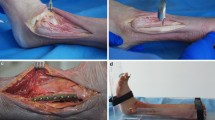Abstract
Purpose
The aim of this study was to identify to what extent a dissection of the syndesmosis and an avulsed posterior edge of the tibia can change the tibiofibular diastasis and fibular rotation.
Methods
Three-dimensional scans with a mobile C-arm of 22 cadaver legs were taken of the intact fibula, after dissection of the anterior part of the syndesmosis and the interosseous membrane, osteotomy of the posterior malleolus, and osteosynthesis. The tibiofibular diastasis as well as the angle of fibular rotation was identified in the four steps and the means compared to each other using a t test for paired samples.
Results
The distinction between the intact fibula vs. the osteotomy of the posterior tibia was 0.082 ± 0.332 mm for the tibiofibular distance in the incisura tibiofibularis (p 0.261) and 0.046 ± 0.486 degrees for the angle of the fibular rotation (p 0.665).
Conclusion
Neither the dissection of the syndesmosis nor the osteotomy of the posterior malleolus significantly influenced the position of the fibula in the incisura tibiofibularis in the cadaveric model. However, in the nonweight-bearing situation, a lesion of the syndesmotic complex might not be evident in intraoperative three-dimensional imaging.









Similar content being viewed by others
Data availability
The datasets used and analysed during the current study are available from the corresponding author on reasonable request.
Abbreviations
- AiTFL:
-
Anterior inferior tibiofibular ligament
- CT:
-
Computed tomography
References
Broos PL, Bisschop AP. Operative treatment of ankle fractures in adults: correlation between types of fracture and final results. Injury. 1991;22:403–6.
Elgafy H, Semaan HB, Blessinger B, et al. Computed tomography of normal distal tibiofibular syndesmosis. Skeletal Radiol. 2010;39:559–64.
Frank M, Bauwens K, Ekkernkamp A. Fractures of the upper ankle. Orthopäde. 2009;38:981–94 (quiz 995–986).
Gonzalez O, Fleming JJ, Meyr AJ. Radiographic assessment of posterior malleolar ankle fractures. J Foot Ankle Surg. 2015;54:365–9.
Grass R, Biewener A, Rammelt S, et al. Aktuelle Überlegungen zur Behandlung von OSG Frakturen. Trauma und Berufskrankheit. 2003;5:141–8.
Heim D. Der posteriore Malleolus bzw. das Volkmann-Dreieck. Der Unfallchirurg. 2013;116:781–8.
Irwin TA, Lien J, Kadakia AR. Posterior malleolus fracture. J Am Acad Orthop Surg. 2013;21:32–40.
Jaskulka RA, Ittner G, Schedl R. Fractures of the posterior tibial margin: their role in the prognosis of malleolar fractures. J Trauma. 1989;29:1565–70.
Lindsjo U. Operative treatment of ankle fracture-dislocations A follow-up study of 306/321 consecutive cases. Clin Orthop Relat Res. 1985;199:28–38.
Mcdaniel WJ, Wilson FC. Trimalleolar fractures of the ankle An end result study. Clin Orthop Relat Res. 1977;122:37–45.
Nault ML, Gascon L, Hebert-Davies J, et al. Modification of distal tibiofibular relationship after a mild syndesmotic injury. Foot Ankle Spec. 2017;10:133–8.
Odak S, Ahluwalia R, Unnikrishnan P, et al. Management of posterior malleolar fractures: a systematic review. J Foot Ankle Surg. 2016;55:140–5.
Patel S, Malhotra K, Cullen NP et al. (2019) Defining reference values for the normal tibiofibular syndesmosis in adults using weight-bearing CT. Bone Joint J 101(b):348–352.
Pichl J, Horlohé K, Hoffmann R. Osteosynthese von Frakturen des oberen Sprunggelenks. Trauma und Berufskrankheit. 2011;13:146–53.
Rammelt S, Grass R, Zwipp H. Ankle fractures. Unfallchirurg. 2008;111:421–37 (quiz 438).
Sman AD, Hiller CE, Refshauge KM. Diagnostic accuracy of clinical tests for diagnosis of ankle syndesmosis injury: a systematic review. Br J Sports Med. 2013;47:620–8.
Sora MC, Strobl B, Staykov D, et al. Evaluation of the ankle syndesmosis: a plastination slices study. Clin Anat. 2004;17:513–7.
Stricker PR, Spindler KP, Gautier KB. Prospective evaluation of history and physical examination: variables to determine radiography in acute ankle injuries. Clin J Sport Med. 1998;8:209–14.
Tejwani NC, Pahk B, Egol KA. Effect of posterior malleolus fracture on outcome after unstable ankle fracture. J Trauma. 2010;69:666–9.
Thordarson DB, Motamed S, Hedman T, et al. The effect of fibular malreduction on contact pressures in an ankle fracture malunion model. The Journal of bone and joint surgery. American. 1997;79:1809–15.
Van Den Bekerom MP, Haverkamp D, Kloen P. Biomechanical and clinical evaluation of posterior malleolar fractures. A systematic review of the literature. J Trauma. 2009;66:279–84.
Van Heest TJ, Lafferty PM. Injuries to the ankle syndesmosis. J Bone Joint Surg Am. 2014;96:603–13.
Vetter SY, Gassauer M, Uhlmann L, et al. A standardised computed tomography measurement method for distal fibular rotation. Eur J Trauma Emerg Surg. 2019;1:1–6.
Vetter SY, Privalov M, Beisemann N, et al. Influence of ankle joint position on angles and distances of the ankle mortise using intraoperative cone beam CT: a cadaveric study. PLoS ONE ONE. 2019;14:e0217737.
Acknowledgements
We thank Prof. Weiss, University of Mannheim, for the statistical analysis and supervision of this study.
Funding
There was no funding for this specific study.
Author information
Authors and Affiliations
Contributions
Dr. Sven Vetter: study design, writing manuscript. Nora Palesche: carried out experiment, performed calculations. Dr. Jochen Franke: developed the theoretical framework. Dr. Nils Beisemann, Dr. Marc Schnetzke, Dr. Holger Keil, Prof. Dr. Joachim Kirsch, Prof. Dr. Paul Alfred Grützner: all authors provided critical feedback and helped shape the study, the analysis and the manuscript.
Corresponding author
Ethics declarations
Conflict of interest
The authors declare that they have no competing interests.
Ethics approval and consent to participate
The application was submitted to the local ethics committee on 13.01.2014 and was accepted on 17.02.2014 with the registration number S-013/2014.
Rights and permissions
About this article
Cite this article
Vetter, S.Y., Palesche, N., Beisemann, N. et al. Influence of syndesmotic injuries and posterior malleolar ankle fractures on fibula position in the ankle joint: a cadaveric study. Eur J Trauma Emerg Surg 47, 905–912 (2021). https://doi.org/10.1007/s00068-019-01292-1
Received:
Accepted:
Published:
Issue Date:
DOI: https://doi.org/10.1007/s00068-019-01292-1




